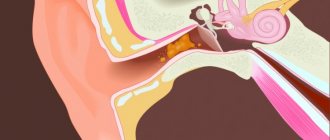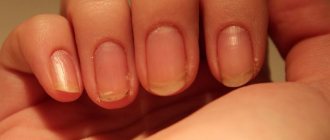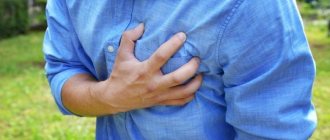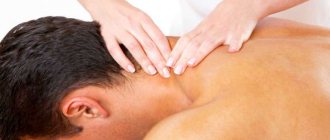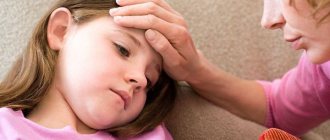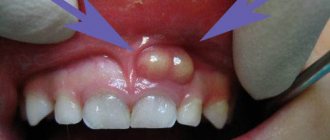The occurrence of painful sensations in the ear is often accompanied by a weakening of auditory function, which significantly worsens a person’s quality of life. When contacting an otolaryngologist, in most cases, a popular inflammatory process is detected, covering the middle part of the ear, nasal or oropharynx. If a sore throat radiates to the ears, a complicated course of the disease should be suspected.
What causes ear pain?
Shooting pain in the right ear (or left) can be caused by chronic otitis media, otosclerosis, mastoiditis, and furunculosis. It often indicates an inflammatory process, so a person should not self-medicate. If you feel severe pain with slight pressure on the ear cartilage, then most likely it is otitis externa. If the pain in the ear is intense and purulent discharge appears, this is inflammation of the follicle.
If, in addition to the listed symptoms, a person’s hearing is severely impaired, then most often it is otitis media. With this disease, body temperature rises, headache and general weakness appear.
If a person has a pressing pain in the ear, this indicates that he has a wax plug or that there is a foreign object in the ear. The color of the fluid secreted during ear pain also provides information about the disease.
If the discharge is gray with white dots, this indicates the appearance of otitis externa. If the discharge in a person's ear is red or bloody, this indicates that the ear is damaged.
Ear pain can be caused by a common ARVI. Neck pain can cause ear pain. Acute sensorineural hearing loss manifests itself in hearing loss, malaise and severe pain.
Causes of shooting pain in the ear
Reasons that can lead to shooting pain in the ear:
- Pressure changes.
- Water getting into the ear.
- Dental diseases.
- Otitis.
- Streptococcal ear infection.
- Mastoiditis.
- Prolonged exposure to the wind with the formation of a “painful bruise.”
- Earwax deficiency.
- Foreign body entering the ear.
- Burn or frostbite of the ear.
- Violation of the integrity of the eardrum.
- Sore throat or sinusitis.
- Penetration into the ear of an insect. This leads to the formation of edema and intense pain.
- Ear injury. If it is severely damaged, blood may flow from the ears.
Pain is not always a sign of any hearing disease. Sometimes it occurs against the background of tooth inflammation. When pressing on it, the pain radiates to various areas: to the neck, to the temple, to the ear.
Sometimes ear pain is accompanied by itching. The person begins to comb it with the help of various objects. This leads to increased inflammation. If the cause of the pain was an infection, then under such conditions it can penetrate into the deep structures of the ear.
Shooting in the ear
Shooting pain above the ear is a fairly common symptom and may represent the following conditions:
- otitis;
- sinusitis;
- sinusitis;
- polyneuropathy caused by alcohol abuse or poisoning with other toxic substances;
- Sluder syndrome;
- Hunt's syndrome;
- advanced caries;
- inflammation of the trigeminal nerve due to the development of infection, injury, hypothermia or tumor.
Causes
Only a doctor can accurately determine the cause of shooting pain above the ear. If they occur, you should immediately contact an ENT specialist and undergo an examination, since advanced inflammation, regardless of its cause, can be complicated by suppuration and neuritis of the trigeminal nerve with the loss of its main functions and functions for which its processes are responsible:
- hearing;
- salivation;
- motor activity of half of the face;
- swallowing;
- partially visual;
- sensitivity of the half of the head for which it is responsible.
Due to the fact that the left and right trigeminal nerves are one of the 12 main pairs of cranial nerves leading directly to the brain, its inflammation, and even more so the development of purulent processes, can lead to inflammation of the brain with all the ensuing consequences, which can only be avoided timely identification of the true causes of the disease and its treatment.
Treatment
If you have shooting pains in the ear or above it, you should not get carried away with traditional medicine, much less heat the sore spot. While this may provide temporary relief, it can also speed up the formation of pus and cause complications. If you cannot see a doctor right away, you can take anti-inflammatory drugs or antibiotics and painkillers, but you should not delay visiting a doctor.
Shooting in the ear: what to do at home?
It is necessary to immediately provide emergency assistance to the victim.
In an adult
Severe shooting pain causes a deterioration in the patient’s general well-being. Do not use ear drops until you consult a doctor. To alleviate the condition, you need to moisten a cotton swab with boric alcohol and place it in the passage, take analgesic tablets and lie down. If a foreign body is suspected, it is prohibited to remove it spontaneously. Then consult a doctor or call an ambulance.
The child has
Many parents have no idea what to do or what help to provide if their child has a shooting ear. If the pain begins in children, you should immediately consult a doctor. It is forbidden to select medications for treatment on your own; you cannot drip alcohol-based products, as this can lead to burns.
If a child is experiencing severe pain, the most a parent can do is:
- examine the ear for the presence of foreign bodies;
- rinse your nose with saline solution;
- place vasoconstrictor drops into the nose;
- give painkillers and, if necessary, antipyretics;
- make a warm compress with salt on the ear.
Shooting without pain
Often, a walk in cold or windy weather results in lumbago in the ears, which can be symptoms of various diseases. Therefore, establishing the cause of their occurrence will avoid the risk of complications. The following are possible reasons for shooting in the ears without pain:
- Inflammatory diseases of the mouth and throat, such as caries and tonsillitis, can cause lumbago in the ear.
- Neuritis of the facial nerve may be accompanied by shooting in the ears.
- Shooting also occurs as a result of ear diseases - types of otitis, labyrinthitis, mastoiditis.
- The consequence of an untreated runny nose (eustacheitis) often manifests itself as discomfort and shooting in the ears.
- The occurrence of lumbago is possible during sudden temperature changes, as well as after airplane flights, accompanied by a sharp change in pressure, which leads to blockage of the Eustachian tube. The basis for this are physiological reasons that do not require intervention and go away on their own.
Shooting in the ears can be bothersome if it appears only on one side of the head. So, lumbago on the left may be caused by arthritic changes in the joints. If the pain in the ear shoots into the head on the right side, this indicates purulent inflammation in the parotid region.
If you experience lumbago in the ears without pain, do not worry. However, if they persist, accompanied by unpleasant sensations, you should seek help in identifying the cause from the following specialists: otolaryngologist, neurologist and therapist.
What is prohibited?
Improper treatment can cause purulent meningitis
In order not to cause harm and prevent the development of complications, you need to know what not to do when you have shooting pain in the ear:
- Do not put alcohol or alcohol-containing medications into the ear. They can cause burns to the mucous membrane.
- Warming should not be performed when pus is released or body temperature is high.
- It is strictly forbidden to clean the ear canal with cotton swabs or use other objects for this.
- If you have ear diseases, you should not go to the bathhouse or sauna. Heat treatments increase body temperature and can complicate the course of the disease.
If you ignore this symptom and do not take measures to eliminate it, then in the future it can contribute to the development of serious complications.
It should be remembered that complications can be caused either by an undertreated disease or by improper self-treatment.
Untreated disease or inadequate treatment may result in hearing loss, brain abscess, or destruction of the eardrum. The inflammatory process can spread to healthy tissues and organs and contribute to the development of destructive processes.
In an advanced form, irreversible processes develop in the body. Pathogenic bacteria have a destructive effect on tissues and as a result, changes occur in the hearing organs. In the future, these changes will cause an exacerbation of ear disease.
More information about otitis media can be found in the video:
Why does wax plug occur and what does it look like?
To avoid the appearance of this unpleasant symptom, it is recommended to adhere to the following rules:
- When swimming and diving in water, use earplugs.
- Avoid drafts.
- Wear a hat according to the weather, and in the winter season be sure to wear a hat.
- Perform ear hygiene in a timely manner. It is not advisable to use ear sticks. It is better to clean with warm water and soap.
- Treat diseases of the nasopharynx and teeth and prevent them from becoming chronic.
- Do not remove foreign bodies from the ear yourself, but it is better to seek help from a specialist. A timely removed foreign object will prevent the inflammatory process from developing.
- When visiting the pool, be sure to wear a cap. This way you can avoid water getting into the ear cavity.
- When blowing your nose, you should pinch each nostril one by one and do not apply much force.
The listed recommendations will help prevent the development of diseases of the ENT organs and their complications.
Sore throat
If your ear begins to hurt, you should start therapy without waiting for complications to arise. Before using ear drops, you must ensure that the membrane is intact. Of course, only a doctor can help with this.
Regardless of whether the disease is traced to the left side or the right, the use of ear drops is prescribed for both ears. This can help not only get rid of clinical signs, but also prevent the spread of infection from the nasopharynx/oropharynx to the second ear. For a diseased ear, a therapeutic dosage is necessary; for a healthy ear, a prophylactic dose is sufficient.
Diagnostics
To diagnose the disease, otoscopy is used (examination using a special device - an otoscope). During the examination, the doctor evaluates the appearance of the external ear canal and the tympanic membrane. If the membrane is damaged, the doctor may examine the cavity behind it.
Depending on the results of the external examination, other research methods are used. The patient is prescribed a general blood test. Signs of progression of the pathology are leukocytosis and increased ESR. Audiometry is used to determine the degree of hearing impairment.
Treatment of throat and ears
If a sore throat shoots into the ear, a systematic therapeutic approach is necessary. Systemic substances are also used in the treatment of ear pain:
- Antihistamines, for example "Tavegil", "Suprastin". They can help reduce swelling of the mucous membrane of the auditory tube, increase its gap, thereby improving ventilation function. Sanitation of the middle ear ensures inhibition of the activity of pathogenic bacteria.
- If nausea occurs, antiemetic drugs are prescribed, for example Cerucal. Vomiting indicates destruction of the inner ear compartment.
- In the absence of purulent masses, but with massive secretion of serous discharge, hormonal drugs are recommended.
- Antipyretics are indicated to combat fever. The use of nonsteroidal anti-inflammatory medications will not only reduce hyperthermia, but also the severity of inflammation.
Causes arising from external influences
What should you do if you have a shooting in your ear and pain occurs when diving, in the mountains, on an airplane, or at a disco? How can you help yourself at home? This phenomenon is observed when sound vibrations change and atmospheric pressure fluctuates. As soon as the load on the hearing organ is removed, the symptoms disappear.
For example, a person flying on an airplane can perform the following exercises: swallow more often, yawn with your mouth wide open, or drip vasodilator drops (naphthyzin, tisin, galazolin) into each nostril.
After long dives, when the ear continues to shoot, you need to jump alternately on one leg, shaking your head well. Then lie down on the side of the sore ear.
To prevent dirt from entering and the development of inflammation, it is recommended to inject 2 drops of a 3% hydrogen peroxide solution into the ear canal. Usually, after the proposed measures, this phenomenon quickly passes.
In cases where lumbago remains, one can suspect infection of the ear cavity with dirty water, or assume that the patient already had an infection before diving.
As you can see, there are many causes of lumbago, and it is not always possible to cope with this symptom on your own. There is no need to wonder “what to do?” If your ear is blown, it shoots, it hurts, and it also “leaks” - run to the otolaryngologist.
"Otirelax"
The drug is used to treat external and barotraumatic otitis. Use two to three times a day, and for the best effect, the drug must be warmed in the palms of your hands. The product must be used with caution, as the patient may have allergies and irritation of the ear canal. "Otirelax" is suitable for children and newborns. The drug should not be used by those who are sensitive to its components or if the eardrum is damaged.
Folk remedies
Ear diseases can be treated using traditional medicine. Infusions of medicinal plants help to quickly relieve pain and stop the pathological process. They allow you to speed up recovery and avoid the development of complications.
Walnut oil
Walnut oil has a pronounced analgesic effect. To make butter, you need to crush several kernels in a mortar. Oil is squeezed out of the nut mass using a garlic press. Oil is dripped into the ear 2-3 times a day (2-3 drops). You can use the oil in another way. A gauze swab moistened with oil is inserted into the ear cavity. After 1-2 hours the tampon can be removed. Before use, the oil must be warmed in your palms.
Applications of geranium
The phytoncides contained in geranium leaves can suppress the proliferation of many types of pathogenic microorganisms. The medicinal plant slows down the inflammatory process and relieves pain. A geranium leaf is rubbed between your palms and rolled into a tube. It is then carefully inserted into the ear. After 3 hours the sheet must be replaced. It is necessary to introduce geranium leaves into the ear even when the pain becomes weaker or disappears.
Calendula infusion
Calendula effectively relieves pain, reduces inflammation and suppresses the activity of pathogenic microflora. To treat ear diseases, you can prepare an infusion of calendula. 2 tbsp. l. flowers are poured with a glass of boiling water. The liquid is infused for 15-20 minutes, then filtered and instilled into the ears, 2-3 drops 3-4 times a day.
An alcoholic infusion of calendula flowers helps to quickly reduce pain. 2 tbsp. l. dry raw materials are poured into a jar and filled with alcohol (100 ml). The product is infused in a dark place for 1 week, then filtered. The prepared calendula infusion is diluted with boiled water (in a ratio of 1:10). The solution is dripped into the ear 2-4 times a day (2-3 drops). You can insert a gauze swab moistened with a solution of calendula infusion into the auricle. It is removed after 1-2 hours.
Chamomile infusion
If the inflammatory process is purulent in nature, it is recommended to rinse with chamomile infusion. 2 tbsp. l. flowers are placed in a glass and boiling water is poured into it. After 15-20 minutes, the liquid is filtered and cooled (to +36...+37 °C). Rinsing is done using a syringe. Before rinsing, you need to tilt your head to the side where the sore ear is located.
Application of onions
Onions help to quickly reduce even severe pain. The onion is peeled, ground in a mortar and the juice is squeezed out of it. It needs to be instilled into the ears 3-4 times a day, 1-2 drops. You can insert cotton swabs soaked in onion juice into the ears. The tampons are left in until they are dry. If you can’t make juice, you can wrap a small piece of onion in gauze and insert it into your ear.
A baked onion helps eliminate pain and speed up the maturation of the boil. The onion is baked in the oven, then wrapped in gauze and inserted into the ear for 1-2 hours. Before using a baked onion, you need to make sure that it will not cause a burn.
Wormwood tincture
For inflammation in the organ of hearing, wormwood tincture is often used. 1.5 tsp. dry herbs are poured into a container, 100 ml of medical alcohol is poured. The vessel is placed in a dark place for 10 days. It needs to be shaken every day. The finished tincture is filtered and used. A cotton swab is dipped in wormwood tincture and inserted into the auricle. When the tampon is dry, it is removed. The procedure is repeated 2-3 times a day. After just 5 procedures, the symptoms of the disease will become less pronounced or disappear.
Treatment of ear diseases with folk remedies can be carried out only after consultation with a doctor and under his supervision. You can do ear rinsing yourself only after examining a doctor, strictly adhering to his recommendations. Self-medication can lead to the spread of infection to healthy tissue and the development of hearing loss.
Traditional methods
Traditional medicine should not be used as primary medicine; it is ideal as an adjunct to drug treatment. Folk remedies will help patients recover faster. How to treat shooting pain in the ear? The following recipes will have a beneficial effect on the ears:
- Beet. It is necessary to peel, chop and boil small beets together with honey. After preparing the mixture, you need to apply it to the ear, which hurts and causes discomfort.
- Vegetable oil. Vegetable oil is a good painkiller that will relieve not only shooting pain, but also aching pain.
- Nut and almond butters are the most popular. They are used as follows: drop two or three drops of oil into each ear and bandage with something warm.
- Beet juice. It is necessary to peel and boil the beets, then extract the juice from it and drip two or three drops into each ear.
- Onion. Wrap a few pieces of onion in cheesecloth and stick it in your ears. Onions will not only relieve pain, but will also have a beneficial effect on a stuffy nose.
- Chamomile infusion. Pour boiling water over a few tablespoons of chamomile, wait until the infusion cools, and strain it. This solution should be used to rinse each ear in turn. Chamomile is a good antiseptic.
- Walnut leaves are another way to relieve shooting pain in the ear. Squeeze the juice from the walnut leaves and drop four drops into each ear. The pain will go away pretty quickly.
- Propolis and honey. Mix honey and propolis tincture in a one-to-one ratio, for example, one spoon of tincture and one spoon of honey. The resulting solution must be dripped two to three times every day.
- Melissa infusion. Pour one spoon of lemon balm into a glass of boiling water. The broth must be allowed to cool and then strain thoroughly. The infusion can be consumed as tea or dropped into each ear.
Ear pain most often occurs at night, it is difficult to relieve, and children suffer the most from it. You shouldn’t delay visiting a doctor, because everything could get worse every minute.
What disease can cause shooting pain
Although the ear can hurt for various reasons, this symptom in most cases indicates the presence of a source of inflammation. The pain resulting from the inflammatory reaction is accompanied by hearing loss, redness and swelling of the tissue. Depending on the type of pathology, other unpleasant sensations may appear.
Acute inflammation of the middle ear
Acute inflammation of the middle ear develops when pathogens enter the cavity located behind the tympanic membrane. Signs of the disease often appear after suffering from rhinitis, flu, sore throat or laryngitis. The infection penetrates the organ of hearing at the time of strong nose blowing or a physiotherapeutic procedure. Infection sometimes occurs hematogenously. The causative agents of scarlet fever, measles, pneumonia, typhoid, influenza and tuberculosis can enter the tympanic cavity from the blood. Reduced immunity contributes to the appearance of a lesion.
The disease is accompanied by decreased hearing, pain and ringing in the ear. If a pyogenic infection occurs, pus accumulates in the middle ear. The purulent contents come out when the tympanic membrane ruptures.
Aerootite
Aerootitis develops after a sharp change in external pressure. Due to the large difference between external and internal pressure, the drum membrane is deformed (retracted or protruded), stretching greatly.
If the pressure changes rapidly, the tissues of the tympanic cavity become injured and inflamed. The inflammatory process that occurs after a pressure surge is catarrhal in nature. If a pyogenic infection occurs, the lesion becomes purulent.
The development of aerootitis is facilitated by diseases of the nasopharynx and upper respiratory tract that provoke swelling of the auditory tube. Due to swelling, the ability of the Eustachian tube to regulate pressure in the tympanic cavity is partially lost. Therefore, in people with a runny nose or sore throat, aerootitis can develop even with small fluctuations in external pressure.
Petrosit
A focus of inflammation in the organ of hearing can cause the development of petrositis - inflammation of the pyramid of the temporal bone. The main symptom of this pathology is headache. It occurs in the area in front of the ear, in the temple, in the lower jaw and behind the eye. Sometimes patients develop abducens nerve palsy, which causes double vision. Double vision intensifies when trying to turn the eyeball towards the outer corner of the eye.
Since the development of petrositis is provoked by a purulent process in the middle ear, inflammation of the pyramid of the temporal bone is purulent in nature. As the pressure inside the lesion increases, pus penetrates into the middle ear. After this, the patient feels relief. As petrositis progresses, the infection often spreads to other parts of the bone.
Mastoiditis
An inflammatory process in the middle ear can lead to the development of mastoiditis - inflammation of the mastoid process of the temporal bone. The mastoid process is located behind the auricle, so when mastoiditis develops, a tumor appears behind the ear.
The skin in the affected area turns red and becomes hot. Patients are bothered by ringing in the ear, decreased hearing and pain behind the auricle, which has a pulsating character.
Mastoiditis develops in cases where, due to the accumulation of pus in the middle ear, the eardrum does not burst. Since the tympanic cavity is not cleaned, the infection spreads to adjacent tissues. The eardrum has a denser structure in young children. Therefore, they are more likely to develop mastoiditis.
Myringitis
Myringitis is an inflammation of the eardrum. The pathology most often develops against the background of various ear diseases. Myringitis is rarely detected as an independent disease. It can be triggered by viruses or injury.
Due to the inflammatory process, blisters filled with exudate appear on the eardrum. Patients complain of mild itching and the sensation of a foreign body in the ear. The pain may be moderate to severe. When the bubbles on the surface of the membrane burst, discharge appears in the ear.
Boils
Since the external auditory canal is covered with skin, a boil may appear in it. A boil is a purulent inflammation of the skin, the source of which is located inside the hair follicle. Most often, the occurrence of boils is associated with the activity of streptococci and staphylococci.
At the stage of boil maturation, a person is tormented by severe shooting pains in the ear. The pain may worsen while talking or eating. Due to swelling of the ear canal, the patient's hearing deteriorates and noise in the ear appears. When the boil bursts, pus flows out. After this, the patient’s condition improves sharply, and the pain disappears.
Acoustic ear injury
Acoustic ear injury is damage to the hearing organ caused by sounds of excessive force and duration. The organ cells responsible for the perception of sound waves have different resistance to noise. Because cells that sense high-frequency sounds are more vulnerable, high-pitched sounds are more likely to cause acoustic injury.
After traumatic sound exposure, a person’s hearing sharply deteriorates. He complains of ringing and pain in his ears. The consequence of acoustic trauma can be dizziness. When exposed to a powerful sound wave, the eardrum sometimes ruptures. In this case, blood appears in the ears. After severe acoustic trauma, hearing loss develops.
Otitis
Otitis is an inflammatory disease of the ear. Depending on the location of the lesion, otitis media can be external, middle and internal. The external form of the pathology is diagnosed when a focus of inflammation appears in the auricle or ear canal.
If the infection causes an inflammatory reaction in the tympanic cavity, a diagnosis of otitis media is made. With internal otitis (labyrinthitis), the lesion is localized in the labyrinth.
When otitis externa develops, the pain becomes more severe during chewing and swallowing. If otitis media progresses, pain may occur not only in the ear, but also in the temple and jaw. With labyrinthitis, the patient often experiences dizziness.

